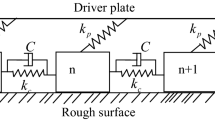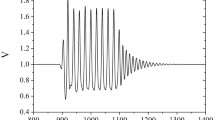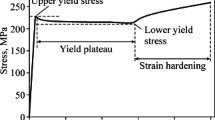Abstract
An overview is given on remarkable progress that has been made in theoretical studies of solitons and other nonlinear wave patterns, excited during the deformation of fault block (fragmented) geological media. The models that are compliant with the classical and perturbed sine-Gordon equations have only been chosen. In these mathematical models, the rotation angle of blocks (fragments) and their translatory displacement of the medium are used as dynamic variables. A brief description of the known models and their geophysical and geodynamic applications is given. These models reproduce the kinematic and dynamic features of the traveling deformation front (kink, soliton) generated in the fragmented media. It is demonstrated that the sine-Gordon equation is applicable to the description of series of the observed seismic data, modeling of strain waves, as well as the features related to fault dynamics and the subduction slab, including slow earthquakes, periodicity of episodic tremor and slow slip (ETS) events, and migration pattern of tremors. The study shows that simple heuristic models and analytical and numerical computations can explain triggering of seismicity by transient processes, such as stress changes associated with solitary strain waves in crustal faults. The need to develop the above-mentioned new (nonlinear) mathematical models of the deformed fault and fragmented media was caused by the reason that it is impossible to explain a lot of the observed effects, particularly, slow redistribution and migration of stresses in the lithosphere, within the framework of the linear elasticity theory.


Similar content being viewed by others
References
Aero EL, Bulygin AN, Pavlov YV (2009) Solutions of the three-dimensional sine-Gordon equation. Theor Math Phys 158:313–319
Barabanov VL, Grinevsky AO, Kissin IG, Mil’kis MP (1988) Hydrogeological and seismic effects of deformational waves in the foremost Kopet Dag Fault zone. Izv Akad Nauk SSSR Fiz Zemli 5:21–31
Bazavluk TA, Yudakhin FN (1993) Deformation waves in Earth crust of Tien Shan on seismological data. Dokl Akad Nauk 329:565–570
Bazavluk TA, Yudakhin FN (1998) Variations in time converted waves producing inhomogeneities in the Tien-Shan earth crust. Dokl Akad Nauk 362:111–113
Braun OM, Kivshar YS (1998) Nonlinear dynamics of the Frenkel-Kontorova model. Phys Rep 306:1–108
Braun OM, Kivshar YS (2004) The Frenkel-Kontorova model: concepts, methods, and applications. Springer, Berlin
Bykov VG (2000) Nonlinear wave processes in geological media. Dal’nauka, Vladivostok (in Russian)
Bykov VG (2001a) Solitary waves on a crustal fault. Volcanol Seismol 22:651–661
Bykov VG (2001b) A model of unsteady-state slip motion on a fault in a rock sample. Izv Phys Solid Earth 37:484–488
Bykov VG (2005) Strain waves in the Earth: theory, field data, and models. Russ Geol Geophys 46:1158–1170
Bykov VG (2006) Solitary waves in crustal faults and their application to earthquakes. In: Teisseyre R, Takeo M, Majewski E (eds) Earthquake source asymmetry, structural media and rotation effects. Springer, Berlin, pp 241–253
Bykov VG (2008) Stick–slip and strain waves in the physics of earthquake rupture: experiments and models. Acta Geophys 56:270–285
Di Bartolomeo M, Massi F, Baillet L, Culla A, Fregolent A, Berthier Y (2012) Wave and rupture propagation at frictional bimaterial sliding interfaces: from local to global dynamics, from stick-slip to continuous sliding. Tribol Int 52:117–131
Dodd RK, Eilbeck JC, Gibbon JD, Morris HC (1982) Solitons and nonlinear wave equations. Academic, London
Eringen A (1968) Theory of micropolar elasticity. In: Liebowitz H (ed) Fracture, vol 2. Academic, New York, pp 621–729
Forsythe GE, Malcolm MA, Moler CB (1977) Computer methods for mathematical computations. Prentice Hall, Englewood Cliffs, New York
Frenkel IY, Kontorova TA (1938) On the theory of plastic deformation and twinning. J Exp Theor Phys 8:89–95 (in Russian)
Garagash IA (1996) Microdeformation of the prestress discrete geophysical media. Dokl Akad Nauk 347:95–98
Garagash IA, Nikolaevskiy VN (2009) Cosserat mechanics in Earth Sciences. Comput Contin Mech 2:44–66 (in Russian)
Gershenzon NI, Bykov VG, Bambakidis G (2009) Strain waves, earthquakes, slow earthquakes, and afterslip in the framework of the Frenkel-Kontorova model. Phys Rev E 79:056601
Gershenzon NI, Bambakidis G, Hauser E, Ghosh A, Greager KC (2011) Episodic tremors and slip in Cascadia in the framework of the Frenkel-Kontorova model. Geophys Res Lett 38, L01309
Johnson PA, Savage H, Knuth M, Gomberg J, Marone C (2008) Effects of acoustic waves on stick-slip in granular media and implications for earthquakes. Nature 451:57–60
Kato A, Obara K, Igarashi T, Tsuruoka H, Nakagawa S, Hirata N (2012) Propagation of slow slip leading up to the 2011 Mw 9.0 Tohoku-Oki Earthquake. Science 335:705–708
Kivshar YS, Malomed BA (1989) Dynamics of solitons in nearly integrable systems. Rev Mod Phys 61:763–911
Kuz’min YO (2012) Deformation autowaves in fault zones. Izv Phys Solid Earth 48:1–16
Lamb GL (1980) Elements of soliton theory. Wiley, New York
Lee WHK, Celebi M, Todorovska MI, Igel H (eds) (2009) Bulletin of the Seismological Society of America, Special Issue: “Supplement. Rotational seismology and engineering applications” 99: 1486 p
Lukk AA, Nersesov IL (1982) Time-dependent parameters of a seismotectonic process. Izv Akad Nauk SSSR Fiz Zemli 3:10–27
Majewski E (2006) Seismic rotation waves: spin and twist solitons. In: Teisseyre R, Takeo M, Majewski E (eds) Earthquake source asymmetry, structural media and rotation effects. Springer, Berlin, pp 255–272
Malamud AS, Nikolaevskii VN (1983) The periodicity of Pamirs-Hindu Kush earthquakes and the tectonic waves in subducted lithosphere plates. Dokl Akad Nauk SSSR 269:1075–1078
Malamud AS, Nikolaevsky VN (1985) Cyclicity of seismotectonic events in the marginal region of the Indian lithospheric plate. Dokl Akad Nauk SSSR 282:1333–1337
McLaughlin D, Scott A (1978) A multisoliton perturbation theory. In: Lonngren K, Scott A (eds) Solitons in action. Academic, New York, pp 201–256
Mikhailov DN, Nikolaevskiy VN (2000) Tectonic waves of the rotational type generating seismic signals. Izv Phys Solid Earth 36:895–902
Nevsky MV, Morozova LA, Zhurba MN (1987) The effect of propagation of the long-period strain perturbations. Dokl Akad Nauk SSSR 296:1090–1093
Nikolaevskii VN (1995) Mathematical modeling of solitary deformation and seismic waves. Dokl Akad Nauk 341:403–405
Nikolaevskiy VN (1996) Geomechanics and fluidodynamics. Kluwer, Dordrecht
Nikolaevskiy VN (1998) Tectonic stress migration as nonlinear wave process along earth crust faults. In: Adachi T, Oka F, Yashima A (eds). Proc. of 4th Inter. Workshop on Localization and Bifurcation Theory for Soils and Rocks, Gifu, Japan, 28 Sept.- 2 Oct. 1997. Balkema, Rotterdam 137–142
Parmentier RD (1978) Fluxions in long Josephson junctions. In: Lonngren K, Scott A (eds) Solitons in action. Academic, New York, pp 173–199
Power WL, Tullis TE (1991) Euclidean and fractal models for the description of rock surface roughness. J Geophys Res 96:415–424
Rogers G, Dragert H (2003) Episodic tremor and slip on the Cascadia subduction zone: the chatter of silent slip. Science 300:1942–1943
Ruzhich VV, Truskov VA, Chernykh EN, Smekalin OP (1999) Recent movements in the fault zones of Pribaikalia and mechanisms of their initiation. Geol Geofiz 40:360–372 (in Russian)
Savage HM, Marone C (2007) Effects of shear velocity oscillations on stick-slip behavior in laboratory experiments. J Geophys Res 112, B02301
Schwartz SY, Rokosky JM (2007) Slow slip events and seismic tremor at Circum-Pacific subduction zones. Rev Geophys 45, RG3004
Scott A (2003) Nonlinear science: emergence and dynamics of coherent structures (second edition). Oxford University Press, New York
Solerno M, Soerensen MP, Skovgaard O, Christiansen PL (1983) Perturbation theories for sine-Gordon soliton dynamics. Wave Motion 5:49–58
Stein RS, Barka AA, Dieterich JH (1997) Progressive failure on the North Anatolian fault since 1939 by earthquake stress triggering. Geophys J Int 128:594–604
Takeo M (2009) Rotational motions observed during an earthquake swarm in April 1998 offshore Ito, Japan. Bull Seismol Soc Am 99:1457–1467
Teisseyre R (2009) Tutorial on new developments in the physics of rotational motions. Bull Seismol Soc Am 99:1028–1039
Teisseyre R, Takeo M, Majewski E (eds) (2006) Earthquake source asymmetry, structural media and rotation effects. Springer Verlag, Berlin
Vikulin AV (2008) Energy and moment of the Earth’s rotation elastic field. Russ Geol Geophys 49:422–429
Whitham GB (1974) Linear and nonlinear waves. Wiley, New York
Wu ZL, Chen YT (1998) Solitary wave in a Burridge-Knopoff model with slip-dependent friction as a clue to understanding the mechanism of the self-healing slip pulse in an earthquake rupture process. Nonlinear Processes in Geophysics 5:121–125
Wu C-F, Lee WHK, Huang H-C (2009) Array deployment to observe rotational and translational ground motions along the Meishan Fault, Taiwan: a progress report. Bull Seismol Soc Am 99:1468–1474
Acknowledgments
The author wishes to thank the reviewers and editors for appraising the submitted manuscript with a critical eye. Their very constructive comments, recommendations, and suggestions contributed to a complete modification of the manuscript. The author acknowledges with great thanks to the very constructive comments and proposals made by Victor Nikolaevskiy which significantly improved the manuscript. Special thanks are due to Natalia Kovriga for improving the manuscript readability.
This work was supported by Program No. 4 of Basic Research of the Presidium of the Russian Academy of Sciences (RAS), under Grant of the Far Eastern Branch of the RAS 12-I-P4-07, and the Russian Foundation for Basic Research (RFBR) and the Japan Society for the Promotion of Science (JSPS), under Grant 13-05-92101 JR_а.
Author information
Authors and Affiliations
Corresponding author
Appendix
Appendix
Here, only those analytical solutions of the sine-Gordon equation are given that have been used by different researchers for developing models of seismic activation of faults, demonstrate the main features of the deformation process in fault zones and explore a relative role of different factors in wave dynamics of the earthquake source.
The classical sine-Gordon equation has the following form:
where ξ and η are the spatial and temporal coordinates; U is the dynamic variable (the rotation angle or displacement of the block or fragment of the medium). If to search for the solution in the shape of a traveling wave (β is the wave velocity),
Equation (25) turns into
Equation (26) has the following well-known solutions:
-
1.
Periodic fast cnoidal waves (0 < k < 1; β 2 > 1):
Solution (27) appears as a traveling wave oscillating close to the value U = 0. Solution (28) corresponds to a periodic wave with an average zero value. V is the velocity of dynamic variable U (the rotation angle or displacement of the block of the geological medium).
-
2.
Periodic slow cnoidal waves (0 < k < 1; β 2 < 1):
Solution (30) represents a periodic sequence of pulses with a spatial period 2k(1 − β 2)1/2 K(k), where K(k) is the complete elliptical integral of the first kind. In expressions (27)–(30), the notations sn(ξ, k), cn(ξ, k), and dn(ξ, k) are the Jacobian elliptic functions; k is the modulus of the elliptic function.
-
3.
Solitary waves (solitons) (\( \begin{array}{cc}\hfill k\to 1;\hfill & \hfill {\beta}^2<1\hfill \end{array} \)):
Solutions (31) and (32) are most frequently encountered in the present overview and have the proper names: the first one is a kink, a wave with invariant profile in the shape of a twist by variable U; the second one is a soliton, a solitary wave, transmitting at velocity β. The above solutions are schematically shown in Fig. 3. Figure 3b, c, corresponding to the solutions (31) and (32) of the sine-Gordon equation, coincides in their shapes with the displacements and velocities of stick-slip at the contact of blocks of rocks, observed in the laboratory experiments (Bykov 2008).
Rights and permissions
About this article
Cite this article
Bykov, V.G. Sine-Gordon equation and its application to tectonic stress transfer. J Seismol 18, 497–510 (2014). https://doi.org/10.1007/s10950-014-9422-7
Received:
Accepted:
Published:
Issue Date:
DOI: https://doi.org/10.1007/s10950-014-9422-7





